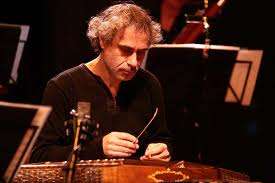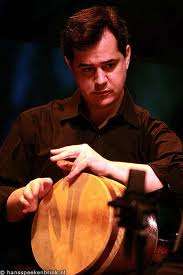|
Back
The Joy of a Thousand Years New York
Grace Rainey Rogers Auditorium, Metropolitan Museum of Art
06/12/2012 -
Orient-Occident: A dialogue of Souls. Ottoman, Armenian, Arabo-Andalusian, Sephardic, Afghan, Persian, Italian, Christian, French, Berber, Portuguese music of the 10th-14th Centuries, including music by Alfonso X e Sabio, Le Manuscript du Roi, Dmitri Catemir and traditional dances and melodies
Jordi Savall (Rebec, bowed lyre, rebab), Dimitri Psonis (Santur, Moorish guitar), David Mayoral (Percussion)

J. Savall (© Metropolitan Museum of Art)
In theory, Jordi Savall’s music embraces the earliest 10th Century melodies up to the late Baroque, the furthest areas of the Middle East to the Ducal territories of Italy and the Holy Roman Empire.
In practice, for decade upon decade, this magnificent Catalan musician, transcends millennia and leaps over continents. With his late partner, Montserrat Figueras, Jordi Savall has resurrected “dead” music the way the Christian Savior resurrected Lazarus: healthy, corporeal , filled with the vigor and energy of life.
A master of musicology and performance, Mr. Savall has mastered several large and small ensembles, and those of us who prize his recordings, have heard the vibrant voice of Ms. Figueras and the astonishing fingers of Mr. Savall on a plethora of stringed and bowed instruments, most of whose names were forgotten and whose musical notes were once footnotes. Ms. Figueras has departed, alas, but Mr. Savall’s journey to New York this week was filled, as always, with treasures to be unearthed.
The venue was appropriately not an ordinary concert hall, but the Grace Rainey Rogers Auditorium, set amidst the treasures of Ancient and Ptolemaic Egypt. And just as Egypt at times, ruled the entire Middle East, so Mr. Savall’s musics included Jewish, Islamic, Catholic, music of courts and streets. The only commonality, as Mr. Savall had written, was “the dialogue of souls.”
The first half of the 20 pieces were played without interruption, and this might have confused some in the audience. Those of us blessed to have lived with the Berbers in Morocco or sleeping in the Persian desert or hiking through the Anatolian mountains, have woken to these eternal sounds (with strong black coffee!) and needed no explanation.
For others, perhaps fearing that these words would be shards of plaintive songs which Folkways Records used to “discover” in the 1950’s, Mr. Savall’s works were revelations. For from the beginning, his music, whether “traditional” or the rare notated manuscripts, is healthy, vigorous and, even in the frequent laments, very alive
The first two were pure Berber, the glistening notes of the rebec and the soft tapping of the drums, the third , an exercise in trills from the work of the musical Portuguese monarch, Alfonso X.
The following Armenian song gave rise to a question. Did Mr. Savall actually “arrange” his music to fit his audience? I ask this because the 10th Century music was too perfect, going from major to minor keys, a series of ideal strophes, so ideal that I couldn’t believe it was the original.
Then again, this could have my prejudice, that “modern” music began in the 16th Century, not Medieval times. Armenians were the rare group with notation of sorts, and perhaps this, unlike the other music, enabled it to evolve.
That was also true in the “estampie” from Le Manuscrit du Roi, music taken from the court singers. In fact, much of the music we ordinarily hear as medieval is actually street music, while the music of the palaces, much played here, was complex, stately.

D. Psonis (© Courtesy of the artist)
At the halfway point, Mr. Savall finally spoke, with a voice as mellifluous, deep and magisterial as his music, introducing his partners, starting with Dmitri Psonis. Mr. Psonis played the santur, a stringed instrument musicologists would call a psaltery, but West Virginians know as the dulcimer. That and the Moorish guitar were ever soft, ever delicate.

D.Mayoral (© Courtesy of the artist)
Most astonishing was percussionist David Mayoral. That is his official title, but not once did his variety of instruments become “percussive” or strident or even approaching loud. His work on the large and small drums and the two tambourines, was like a harp or a Chopin etude. Absolutely astonishing fingerwork.
And this was nowhere better played than an Afghan Nastaran. (That word comes from the Farsi, but quite rightly, Mr. Savall called it Afghan, for indeed it came from the easternmost regions of the Persian Empire.) This was music with a cadenza for Mr. Mayoral, about eight minutes where not a single note on his drum rose above a mezzo forte, where the fingers were like hives of bees buzzing and swirling and looking for the right place.
The pieces ran the gamut from the laments to the dances to an exquisite piece from the old Jewish community of ancient Sarajevo, dedicated by Mr. Savall to the diverse people of that once magnificent town.
The most touching moment was the encore, where the three musicians played live under a recording by Montserrat Figueras performing a Sephardic song with perfect musicianship, vigor and splendor.
Most of all, the late Catalan singer sung with joy, real joy. And that was the keystone of Jordi Savall’s music. What a shame that Ms. Figueras was taken from the earth so soon. But what a treasure that she could be heard last night, her voice, like her music, inevitably to be cherished for millennia as far in time and space as the eternity of music itself.
Harry Rolnick
|